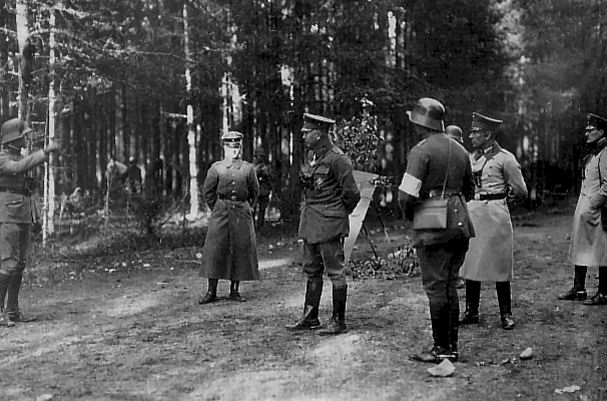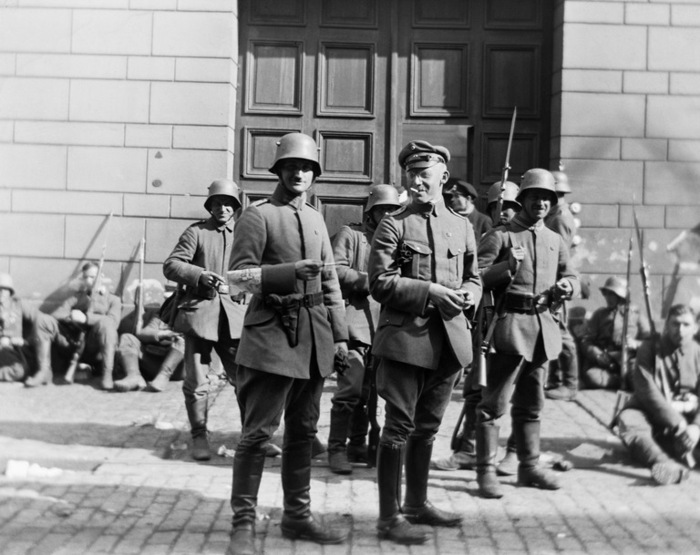Baltic Sea Division on:
[Wikipedia]
[Google]
[Amazon]
 The Baltic Sea Division () was a 10,000 man
The Baltic Sea Division () was a 10,000 man  During the
During the
"The Finnish Collection of Decrees 65/1918 pp.44-46."
History of Finland: A selection of events and documents. Retrieved 7 February 2010. On 11 November 1918, the armistice ended World War I. Von der Goltz and his division left Helsinki on 16 December 1918
 The Baltic Sea Division () was a 10,000 man
The Baltic Sea Division () was a 10,000 man German
German(s) may refer to:
* Germany (of or related to)
** Germania (historical use)
* Germans, citizens of Germany, people of German ancestry, or native speakers of the German language
** For citizens of Germany, see also German nationality law
**Ge ...
military unit commanded by Rüdiger von der Goltz
Gustav Adolf Joachim Rüdiger Graf von der Goltz (8 December 1865 – 4 November 1946) was a German army general during the First World War. He commanded the Baltic Sea Division, which successfully intervened in the Finnish Civil War in the spr ...
. The core of the division comprised two army brigades from the German Eastern Front: 95. Reserve Infantry Brigade (led by Colonel K. Wolff) and 2. Guards Cavalry Brigade (led by Colonel H. von Tschirsky und von Bögendorff). They were supported by additional artillery and pioneer troops, and transported to Finland by a naval squadron led by Hugo Meurer
Hugo Meurer (28 May 1869 – 4 January 1960) was a vice-admiral of the Kaiserliche Marine (German Imperial Navy). Meurer was the German naval officer who handled the negotiations of the internment of the German fleet in November 1918 at the e ...
.
The military activity of the division in Finland served part of the foreign policy of the German Empire after the Treaty of Brest-Litovsk
The Treaty of Brest-Litovsk (also known as the Treaty of Brest in Russia) was a separate peace treaty signed on 3 March 1918 between Russia and the Central Powers (Germany, Austria-Hungary, Bulgaria, and the Ottoman Empire), that ended Russia's ...
with Soviet Russia
The Russian Soviet Federative Socialist Republic, Russian SFSR or RSFSR ( rus, Российская Советская Федеративная Социалистическая Республика, Rossíyskaya Sovétskaya Federatívnaya Soci ...
, signed on 3 March 1918. Germany aimed to establish a chain of satellite states in eastern Europe in order to provide raw materials for German industry and food products for the German people.
The Finnish
Finnish may refer to:
* Something or someone from, or related to Finland
* Culture of Finland
* Finnish people or Finns, the primary ethnic group in Finland
* Finnish language, the national language of the Finnish people
* Finnish cuisine
See also ...
Senate of Vaasa
The Senate of Finland ( fi, Suomen senaatti, sv, Senaten för Finland) combined the functions of cabinet and supreme court in the Grand Duchy of Finland from 1816 to 1917 and in the independent Finland from 1917 to 1918.
The body that would beco ...
had requested German military aid for the Whites
White is a racialized classification of people and a skin color specifier, generally used for people of European origin, although the definition can vary depending on context, nationality, and point of view.
Description of populations as ...
. The Finnish Senate paid all the financial costs of the military intervention of the Baltic Sea Division and urged the Finnish people to provide food, shelter, and any other aid needed by the Baltic Sea Division.
 During the
During the Finnish Civil War
The Finnish Civil War; . Other designations: Brethren War, Citizen War, Class War, Freedom War, Red Rebellion and Revolution, . According to 1,005 interviews done by the newspaper ''Aamulehti'', the most popular names were as follows: Civil W ...
, on 3 April 1918, it landed at Hanko and moved towards Helsinki
Helsinki ( or ; ; sv, Helsingfors, ) is the capital, primate, and most populous city of Finland. Located on the shore of the Gulf of Finland, it is the seat of the region of Uusimaa in southern Finland, and has a population of . The city ...
and Lahti
Lahti (; sv, Lahtis) is a city and municipality in Finland. It is the capital of the region of Päijänne Tavastia (Päijät-Häme) and its growing region is one of the main economic hubs of Finland. Lahti is situated on a bay at the southern e ...
. The Baltic Sea Division quickly took Helsinki from the Red Guards
Red Guards () were a mass student-led paramilitary social movement mobilized and guided by Chairman Mao Zedong in 1966 through 1967, during the first phase of the Cultural Revolution, which he had instituted.Teiwes According to a Red Guard lead ...
, who had previously deposed the official government in Helsinki. This enabled the Senate to return to Helsinki.
Arimo 1991, Kruhse, Pauli"The Finnish Collection of Decrees 65/1918 pp.44-46."
History of Finland: A selection of events and documents. Retrieved 7 February 2010. On 11 November 1918, the armistice ended World War I. Von der Goltz and his division left Helsinki on 16 December 1918
See also
*Detachment Brandenstein
Detachment Brandenstein was a unit commanded by German Baron Otto von Brandenstein. The 3,000 man unit which fought in the Finnish Civil War by landing at Loviisa April 7, 1918. Its assigned mission was to cut the Reds' railway connections by att ...
*Battle of Helsinki
The Battle of Helsinki was a 1918 Finnish Civil War battle, fought in 12–13 April between the German troops and Finnish Whites against the Finnish Reds in Helsinki, Finland. Together with the battles of Tampere and Vyborg, it was one of the ...
References
Further reading
* * German divisions of World War I Finnish Civil War Military units and formations established in 1918 Military units and formations disestablished in 1919 German expatriates in Finland {{WWI-stub